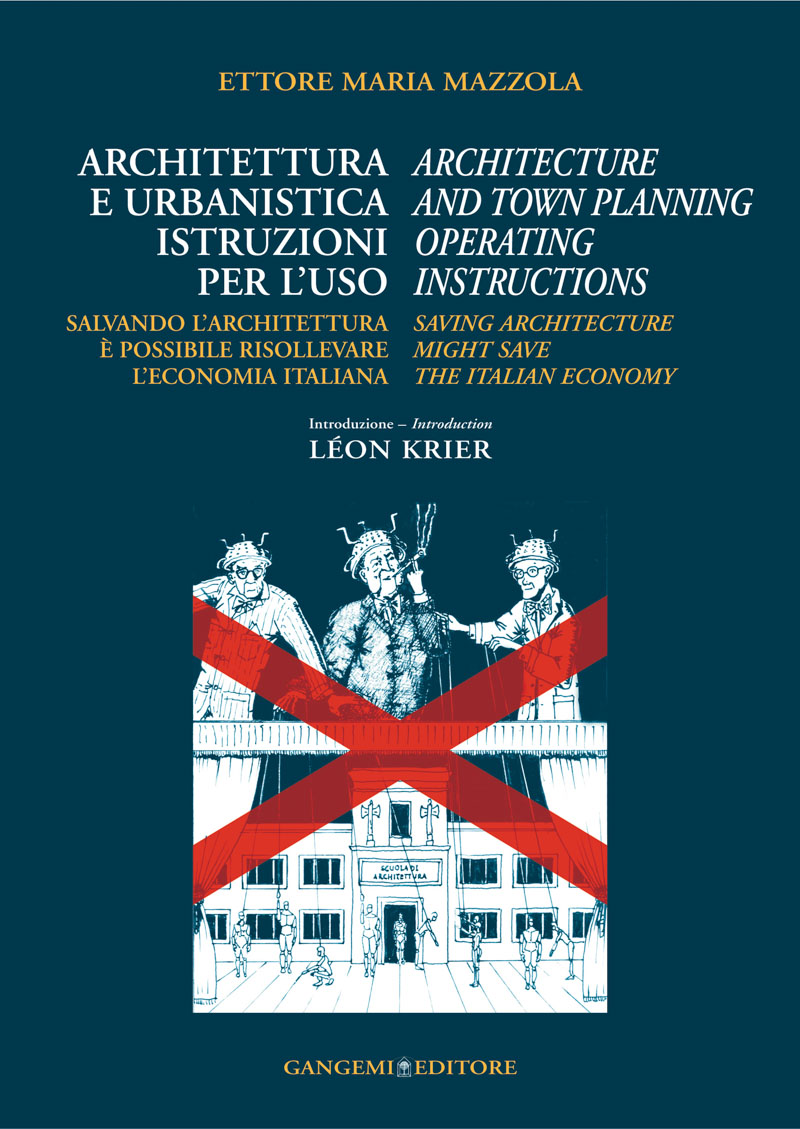
30,00 €
Potrebbero interessarti anche
Architettura e Urbanistica. Istruzioni per l’uso / Architecture and Town Planning. Operating Instruction
Salvando l'architettura è possibile salvare l'economia italiana / Saving Architecture might save the Italian Economy
Autori: Mazzola Ettore Maria
Facing English text
Formato: 17 x 24 cm
Legatura: Filorefe
Pagine: 144
Anno edizione: 2006
ISBN: 9788849209839
EAN: 8849209835
UB. INT. : T444E V01c V43e V36g V34e
Contenuto
“Ettore Mazzola, con la giusta indignazione, fa notare che, a dispetto dell’assoluto fallimento modernista nel produrre architetture durevoli ed utili per il bene comune, gli architetti modernisti continuano con impenitente arroganza a reclamare la loro proprietà esclusiva dell’idea di modernità. Mazzola aggiunge la sua voce a quella della moltitudine di altri architetti di tutto il mondo i quali, negli ultimi trent’anni, hanno dimostrato la validità della moderna architettura tradizionale a livello ecologico, urbano ed architettonico”
“Ettore Mazzola observed with righteous indignation that notwithstanding the utter failure of modernism to provide an enduring architecture that serves the Common Good, modernist architects continue with unrepentant arrogance to claim exclusive ownership of the idea of modernity. He adds his voice to those of a multitude of other architects around the world, who, for the past thirty years, have been demonstrating the soundness of modern traditional architecture on ecological, urban and architectural levels”
Samir Younés
Director of Rome Studies University of Notre Dame
ESTRATTI DAL TESTO – EXTRACTS
Non dico un’eresia affermando che oggi, se viaggiando in aereo fossimo costretti ad atterrare a sorpresa in una località diversa da quella programmata, e conseguentemente cercassimo di capire dove ci troviamo guardando gli edifici che ci circondano, non avremmo alcuna possibilità di comprendere in quale angolo del Pianeta Terra siamo arrivati!
Quasi tutto ciò che il XX secolo ha prodotto in Architettura – e che apparentemente il XXI si appresta a produrre – ci appare dannatamente votato ad un carattere temporaneo, figlio della concezione “Futurista” dell’Architettura. Concezione lontanissima dalla volontà della gente comune.
Apparentemente, in questo mondo che ha deciso di perdere la cognizione del tempo correndo ad una velocità superiore alle sue capacità, gli architetti sembrano interessarsi alle sole gratificazioni del momento, con nessun interesse per gli impegni del passato e gli obblighi del futuro … chi pagherà per le loro scelte transitorie?
Apparentemente, contro questo capriccio architettonico della cricca modernista, a nulla valgono le costanti sommosse popolari in occasione dell’apertura di nuovi cantieri: questi architetti, abituati ad autogratificarsi, sono così miopi da non rendersi conto che nei loro confronti la gente prova solo un grande senso di preoccupazione e risentimento.
Se le cose non cambiano, le decisioni di merito sull’Architettura e l’Urbanistica non possono essere affidate al solo architetto, soprattutto alla luce dei risultati di 80 anni di pessima amministrazione – dittatoriale e modernista – che ne ha fatto della cosa!
Volendo analizzare sommariamente il fattore economico dell’edilizia cosiddetta moderna e contemporanea, potremmo limitarci a fare i conti in tasca ai suoi proprietari – pubblici o privati.
Immediatamente potremmo verificare che, già pochi anni dopo l’ultimazione dei lavori – molto prima dell’estinzione del mutuo bancario acceso per l’acquisto – quella gente ignara è stata costretta a spendere nuovamente tanti soldi per restaurare ciò che geneticamente si rifiuta di vivere.
È arduo doversi rassegnare all’idea che, nonostante gli sforzi economici fatti per acquistare la casa, quella non potrà essere tramandata ai propri figli.
Le nostre Facoltà di Architettura hanno accettato l’ignorante scelta di “azzerare la storia”, i nostri insegnanti hanno deciso di non insegnare più l’Architettura in nome di un più proficuo design industriale e, a poco a poco, le nostre maestranze specializzate non hanno più avuto clienti da soddisfare perché non c’erano più architetti in grado di dargli lavoro e, lentamente, sono andate scomparendo.
Oggi tutta questa situazione inizia a minare anche il patrimonio antico, risulta sempre più difficile e costoso trovare del personale in grado di intervenire manualmente per il restauro degli edifici storici e, a meno di un’inversione di tendenza, di un brusco risveglio, anche il nostro tesoro artistico non potrà più essere restaurato. Alla luce di tutto questo mi chiedo: come possiamo parlare di modernità relativamente all’Architettura del secolo appena concluso?
It is not heretical to say that nowadays, if air travelers were forced to make an unscheduled landing in some location that was not their original destination, and tried then to understand where they were by looking at the buildings around them, they would have no way of understanding what corner of the Planet Earth they had reached!
Almost everything the twentieth century has produced in Architecture – and apparently the twenty-first is about to follow suit – seems condemned to assume a temporary character, as a result of the “Futurist” conception on Architecture. Conception is totally divorced from what people want.
Apparently in a world which has decided to abandon any awareness of time racing ahead beyond its own capacities, architects seem interested only in transitory gratifications, with no interest in any commitment toward the past and future obligations… who will pay the price for their ephemeral choices?
Apparently the public outcries when new works are undertaken have no effect against this architectural caprice of the modernist clique: these architects, used to self-gratification, are so short-sighted that they do not realize that people feel only concern about- and resentment toward them.
If things do not change, decisions taken on matters of Architecture and Town Planning cannot be left up to the architect alone, especially in the light of the results over 80 years of terrible – dictatorial and modernist – administration!
If we were briefly to summarize the economic factor of the so-called modern and contemporary building, we could limit ourselves to verifying the public and private accounting.
We will immediately be able to ascertain that just a few years after the works were completed – well before paying off the mortgage – those unsuspecting people were forced to spend a lot of money once more to restore what they would, genetically speaking, refuse to live in.
It is an arduous task to have to resign oneself to the idea that despite the efforts made to find the money to buy a home, it cannot be passed down to one’s own children.
Our Schools of Architecture have, in their ignorance, accepted the decision to “cancel history”. Our teachers have decided not to teach architecture any longer in favor of more lucrative industrial design. Little by little, our specialized workers have lost their customers because there were no longer any architects capable of offering them work… and little by little, they were dwindling away.
Now, given this situation in its entirety, even the ancient heritage is being undermined. It is more and more difficult and expensive to find the personnel capable of performing manual work to restore historical buildings. Unless this situation is reversed, and there is a rude awakening, it will no longer be possible to restore our artistic treasure. In the light of all that, I wonder how we can speak of modernity in relation to the Architecture of the century that has just ended?
Parole chiave
Condividi su












